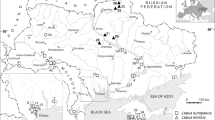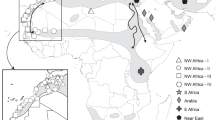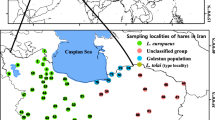Abstract
North African hares are currently included in cape hares, Lepus capensis sensu lato, a taxon that may be considered a superspecies or a complex of closely related species. The existing molecular data, however, are not unequivocal, with mtDNA control region sequences suggesting a separate species status and nuclear loci (allozymes, microsatellites) revealing conspecificity of L. capensis and L. europaeus. Here, we study sequence variation in the intron 6 (468 bp) of the transferrin nuclear gene, of 105 hares with different coat colour from different regions in Tunisia with respect to genetic diversity and differentiation, as well as their phylogenetic status. Forty-six haplotypes (alleles) were revealed and compared phylogenetically to all available TF haplotypes of various Lepus species retrieved from GenBank. Maximum Likelihood, neighbor joining and median joining network analyses concordantly grouped all currently obtained haplotypes together with haplotypes belonging to six different Chinese hare species and the African scrub hare L. saxatilis. Moreover, two Tunisian haploypes were shared with L. capensis, L timidus, L. sinensis, L. yarkandensis, and L. hainanus from China. These results indicated the evolutionary complexity of the genus Lepus with the mixing of nuclear gene haplotypes resulting from introgressive hybridization or/and shared ancestral polymorphism. We report the presence of shared ancestral polymorphism between North African and Chinese hares. This has not been detected earlier in the mtDNA sequences of the same individuals. Genetic diversity of the TF sequences from the Tunisian populations was relatively high compared to other hare populations. However, genetic differentiation and gene flow analyses (AMOVA, FST, Nm) indicated little divergence with the absence of geographically meaningful phylogroups and lack of clustering with coat colour types. These results confirm the presence of a single hare species in Tunisia, but a sound inference on its phylogenetic position would require additional nuclear markers and numerous geographically meaningful samples from Africa and Eurasia.




Similar content being viewed by others
References
Alves PC, Ferrand N, Suchentrunk F, Harris DJ (2003) Ancient introgression of Lepus timidus mtDNA into L. granatensis and L. europaeus in the Iberian Peninsula. Mol Phylogenet Evol 27:70–80
Alves PC, Harris DJ, Melo-Ferreira J, Branco M, Ferrand N, Suchentrunk F, Boursot P (2006) Hares on thin ice: introgression of mitochondrial DNA in hares and its implications for recent phylogenetic analyses. Mol Phylogenet Evol 40:640–641
Alves PC, Melo-Ferreira J, Branco M, Suchentrunk F, Ferrand N, Harris DJ (2008) Evidence for genetic similarity of two allopatric European hares (Lepus corsicanus and L. castroviejoi) inferred from nuclear DNA sequences. Mol Phylogenet Evol 46:1191–1197
Angermann R (1965) Revision der palaearktischen und äthiopischen Arten der Gattung Lepus (Leporidae, Lagomorpha). PhD thesis, Humboldt University of Berlin
Angermann R (1983) The taxononmy of Old World Lepus. Acta Zool Fennica 174:17–21
Angermann R, Feiler A (1988) Zur Nomenklatur, Artabgrenzung und Variabilität der Hasen (Gattung Lepus) im westlichen Afrika (Mammalia, Lagomorpha, Leporidae). Zool Abh Staat Mus Tierkd Dresden 43:149–167
Avise JC (1989) Gene trees and organismal histories: a phylogenetic approach to population biology. Evolution 43:1192–1208
Avise JC (2000) Phylogeography—the history and formation of species. Harvard University Press, Cambridge
Avise JC, Arnold J, Ball RM, Bermingham E, Lamb T, Neigel JE, Reeb CA, Sanders NC (1987) Intraspecific phylogeography: the mitochondrial DNA bridge between population genetics and systematics. Ann Rev Ecol Syst 18:489–522
Bandelt H-J, Forster P, Rohl A (1999) Median-joining networks for inferring intraspecific phylogenies. Mol Biol Evol 16:37–48
Beerli P (2006) Comparison of Bayesian and maximum likelihood inference of population genetic parameters. Bioinformatics 22:341–345
Beerli P, Felsenstein J (2001) Maximum likelihood estimation of a migration matrix and effective population sizes in n subpopulations using a coalescent approach. PNAS 98:4563–4568
Belkhir K (1999) Genetix, Version 4.0. A Windows Program for Population Genetic Analysis. Laboratoire Genome, Populations: Interactions UPR 9060 du CNRS, Université Montpellier 2, Montpellier, France
Ben Slimen H (2008) Phylogénie morphologique et moléculaire des lièvres d’Afrique du Nord du genre Lepus. PhD thesis, Faculty of Sciences of Tunis
Ben Slimen H, Suchentrunk F, Memmi A, Ben Ammar Elgaaied A (2005) Biochemical genetic relationships among Tunisian hares (Lepus sp.), South African cape hares (L. capensis), and European brown hares (L. europaeus). Biochem Genet 43:577–596
Ben Slimen H, Suchentrunk F, Memmi A, Sert H, Kruyger U, Alves PC, Ben Ammar Elgaaied A (2006) Evolutionary relationships among hares from North Africa (Lepus sp. or Lepus spp.), cape hares (L. capensis) from South Africa, and brown hares (L. europaeus), as inferred from mtDNA PCR-RFLP and allozyme data. J Zool Syst Evol Res 44:88–99
Ben Slimen H, Suchentrunk F, Shahin AB, Ben Ammar Elgaaied A (2007) Phylogenetic analysis of mtCR-1 sequences of Tunisian and Egyptian hares (Lepus sp.or spp., Lagomorpha) with different coat colours. Mamm Biol 72:224–239
Ben Slimen H, Suchentrunk F, Ben Ammar Elgaaied A (2008a) On shortcomings of using mtDNA sequence divergence for the systematics of hares (genus Lepus): an example from cape hares. Mamm Biol 73:25–39
Ben Slimen H, Suchentrunk F, Stamatis C, Mamuris Z, Sert H, Alves PC, Kryger U, Shahin AB, Ben Ammar Elgaaied A (2008b) Population genetics of cape and brown hares (Lepus capensis and L. europaeus): a test of Petter’s hypothesis of conspecificity. Biochem Syst Ecol 36:22–39
Brower AVZ, DeSalle R, Vogler A (1996) Gene trees, species trees, and systematics: a cladistic perspective. Ann Rev Ecol Syst 27:423–450
Campos R, Storz JF, Ferrand N (2012) Copy number polymorphism in the α-globin gene cluster of European rabbit (Oryctolagus cuniculus). Heredity 108:531–536
Cheniti TL (1995) Les mammifères, dans l´ étude nationale de la diversité biologique de la Tunisie. La page Infographique edn, Tunis, Tunisia
Drummond AJ, Ho SY, Phillips MJ, Rambaut A (2006) Relaxed phylogenetics and dating with confidence. PLoS Biol 4:e88
Drummond AJ, Rambaut A (2007) BEAST: Bayesian evolutionary analysis by sampling trees. BMC Evol Biol 7:214
Drummond AJ, Suchard MA, Xie D, Rambaut A (2012) Bayesian phylogenetics with BEAUti and the BEAST 1.7. Mol Biol Evol 29:1969–1973
Ellerman JR, Morrison-Scott TCS (1951) Checklist of palaearctic and Indian mammals. British Museum of Natural History, London, London
Faber D, Hecht W, Herzog A, Kugelschafter K (1997) Populationsgenetische untersuchungen am feldhasen (Lepus europaeus Pallas, 1778) in hessen auf der ebene der mitochondrion DNS-erste Ergebnisse (in German). Beitäge zur Jagd-und Wildforschung 22:181–186
Fickel J, Schmidt A, Putze M, Spittler H, Ludwig A, Streich WJ, Pitra C (2005) Genetic structure of populations of European brown hare: implications for management. J Wildlife Manag 69:760–770
Flux JEF (1983) Introduction to taxonomic problems in hares. Acta Zool Fennica 174:7–10
Flux JEC, Angermann R (1990) Hares and Jackrabbits. In: Chapman JA, Flux JEC (eds) Rabbits, hares and pikas. Status survey and conservation action plan. IUCN, Gland
Fu Y-X, Li W-H (1993) Statistical tests of neutrality of mutations. Genetics 133:693–709
Garrick RC, Sunnucks P, Dyer RJ (2010) Nuclear gene phylogeography using PHASE: dealing with unresolved genotypes, lost alleles, and systematic bias in parameter estimation. BMC Evol Biol 10:118
Gebremariam TZ (2013) Evolutionary Relationships among Hares (Lepus spp.) from Ethiopia: Multivariate Morphometry, Molecular Phylogenetics and Population Genetics. PhD thesis, Addis Ababa University
Halanych KM, Robinson TJ (1999) Multiple substitutions affect the phylogenetic utility of Cytochrome b and 12S rDNA data: examining a rapid radiation in leporid (Lagomorpha) evolution. J Mol Evol 48:369–379
Hall TA (1999) BioEdit: a user-friendly biological sequence alignment editor and analysis program for Windows 95/98/NT. Nucleic Acids Symp Ser 41:95–98
Hall BG (2011) Phylogenetic trees made easy: a how-to manual, 4th edn. Sinauer Associates, Sunderland 282
Harrigan RJ, Mazza ME, Sorenson MD (2008) Computation vs. cloning: evaluation of two methods for haplotype determination. Mol Ecol Resour 8:1239–1248
Hartl GB, Suchentrunk F, Nadlinger K, Willing R (1993) An integrative analysis of genetic differentiation in the brown hare Lepus europaeus based on morphology, allozymes, and mitochondrial DNA. Acta Theriol 38(Suppl 2):33–57
Heled J, Drummond AJ (2010) Bayesian inference of species trees from multilocus data. Mol Biol Evol 27:570–580
Hoffmann RS, Smith AT (2005) Order Lagomorpha. In: Wilson DE, Reeder DAM (eds) Mammal species of the world, 3rd edn, vol 1. John Hopkins University Press, Baltimore, pp 185–211
Jamet P (1991) Flore et faune du Sahara depuis 18.000 B.P. Actes du Congrès Nationale des Sociétés Savantes 116:55–69
Kasapidis P, Suchentrunk F, Magoulas A, Kotoulas G (2005) The shaping of mitochondrial DNA phylogeographic patterns of the brown hare (Lepus europaeus) under the combined influence of Late Pleistocene climatic fluctuactions and antrhopogenic translocations. Mol Phylogenet Evol 34:55–66
Klein RG (1984) Mammalian extinctions and Stone Age people in Africa. In: Martin PS, Klein RG (eds) Quaternary extinctions: a prehistoric revolution. The University of Arizona Press, Tucson, pp 553–573
Kryger U (2002) Genetic variation among South African hares (Lepus spec.) as inferred from mitochondrial DNA and microsatellites. PhD thesis, University of Pretoria, RSA, pp. 183
Librado P, Rozas J (2009) DnaSP v5: a software for comprehensive analysis of DNA polymorphism data. Bioinformatics 25:1451–1452
Liu J, Yu L, Michael LA, Chun-Hua W, Shi-Fang W, Xin L, Ya-Ping Z (2011) Reticulate evolution: frequent introgressive hybridization among Chinese hares (genus lepus) revealed by analyses of multiple mitochondrial and nuclear DNA loci. BMC Evol Biol 11:223
Maddison WP (1997) Gene trees in species trees. Syst Biol 46:523–536
Melo-Ferreira J, Boursot P, Suchentrunk F, Ferrand N, Alves PC (2005) Invasion from the cold past: extensive introgression of mountain hare (Lepus timidus) mitochondrial DNA into three other hare species in northern Iberia. Mol Ecol 14:2459–2464
Melo-Ferreira J, Alves PC, Freitas H, Ferrand N, Boursot P (2009) The genomic legacy from the extinct Lepus timidus to the three hare species of Iberia: contrast between mtDNA, sex chromosomes and autosomes. Mol Ecol 18:2643–2658
Melo-Ferreira J, Alves PC, Rocha J, Ferrand N, Boursot P (2011) Interspecific XChromosome and Mitochondrial DNA Introgression in the Iberian hare: selection or Allele Surfing? Evolution 65:1956–1968
Melo-Ferreira J, Boursot P, Carneiro M, Esteves PJ, Farelo L, Alves PC (2012) Recurrent Introgression of mitochondrial DNA among hares (Lepus spp.) revealed by species-tree inference and coalescent simulation. Syst Biol 61(3):367–381
Melo-Ferreira J, Farelo L, Freitas H, Suchentrunk F, Boursot P, Alves PC (2014a) Home-loving boreal hare mitochondria survived several invasions in Iberia: the relative roles of recurrent hybridisation and allele surfing. Heredity 112:265–273
Melo-Ferreira J, Seixas FA, Cheng E, Mills LS, Alves PC (2014b) The hidden history of the snowshoe hare, Lepus americanus: extensive mitochondrial DNA introgression inferred from multilocus genetic variation. Mol Ecol 23:4617–4630
Moore WS (1995) Inferring phylogenies from mtDNA variation: mitochondrial-gene trees versus nuclear-gene trees. Evolution 49(4):718–726
Morrison DA (2012) An introduction to phylogenetic networks. RJR Production, Uppsala, p 216
Moulton V, Huber KT (2009) Split networks. A tool for exploring complex evolutionary relationships in molecular data. In: Lemey P, Salemi M, Vandamme A-M (eds) The phylogenetic handbook: a practical approach to phylogenetic analysis and hypothesis testing. Cambridge University Press, Cambridge, pp 631–653
Nichols R (2001) Gene trees and species trees are not the same. Tree 16:358–364
Nowak, RM (Ed) (1999) Walker’s mammals of the world, 5th edn, vol 1. John Hopkins Press, Baltimore
Osborn DJ, Helmy I (1980) The contemporary land mammals of Egypt (including Sinai). Fieldiana Zoology 5, publ. 1309
Pachur HJ, Altmann N (2006) Die Sahara im Spätquartär: Ökosystemwandel im größten hyperariden Raum der Erde. Springer, Heidelberg, Berlin, pp 662
Pérez-Suárez G, Palacios F, Boursot P (1994) Speciation and paraphyly in western Mediterranean hares (Lepus castroviejoi, L. europaeus, L. granatensis, and L. capensis) revealed by mitochondrial DNA phylogeny. Biochem Genet 32:423–436
Petter F (1959) Eléments d’une révision des lièvres africains du sous-genre Lepus. Mammalia 23:41–67
Petter F (1961) Eléments d’une révision des lièvres européens et asiatiques du sous-genre Lepus. Zeitschrift für Säugetierkunde 26:1–11
Petter F (1972) Les lagomorphes du Maroc. Société Des Sciences Naturelles et Physiques du Maroc 52:122–129
Pierpaoli M, Trocchi V, Randi E (1999) Species distinction and evolutionary relationships of the Italian hare (Lepus corsicanus) as described by mitochondrial DNA sequencing. Mol Ecol 8:1805–1817
Posada D (2008) jModelTest: phylogenetic model averaging. Mol Biol Evol 25:1253–1256
Robinson TJ (1986) Incisor morphology as an aid in the systematics of the South African Leporidae (Mammalia: Lagomorpha). South Afr J Zool 21:297–302
Rogers AR, Harpending H (1992) Population growth makes waves in the distribution of pairwise genetic differences. Mol Biol Evol 9:552–569
Schneider S, Roessli D, Excoffier L (2000) Arlequin ver. 2.000: A software for population genetics data analysis. Genetics and Biometry Laboratory, University of Geneva, Switzerland
Simonsen KL, Churchill GA, Aquadro CF (1995) Properties of statistical tests of neutrality for DNA polymorphism data. Genetics 141:413–429
Stephens M, Donnelly P (2003) A comparison of bayesian methods for haplotype reconstruction from population genotype data. Am J Hum Genet 73:1162–1169
Stephens M, Smith NJ, Donnelly P (2001) A new statistical method for haplotype reconstruction from population data. Am J Hum Genet 68:978–989
Suchentrunk F, Davidovic M (2004) Evaluation of the classification of Indian hares (Lepus nigricollis) into the genus Indolagus Gureev, 1953 (Leporidae, Lagomorpha). Mamm Biol 69:46–57
Suchentrunk F, Polster K, Giacometti M, Ratti P, Thulin C-G, Ruhlé C, Vasiliev AG, Slotta-Bachmayr L (1999) Spatial partitioning of allozyme variability in European mountain hares (Lepus timidus): gene pool divergence across a disjunct distributional range? Z Säugetierkunde 64:1–11
Suchentrunk F, Flux JEC, Flux MM, Ben Slimen H (2007) Multivariate discrimination between East African cape hares (Lepus capensis) and savanna hares (L. victoriae) based on occipital bone shape. Mamm Biol 72:372–383
Suchentrunk F, Ben Slimen H, Sert H (2008) Phylogenetic aspects of nuclear and mitochondrial gene-pool characteristics of South and North African Cape hares (Lepus capenis) and European hares (Lepus europaeus). In: Alves PC, Ferrand N, Hackländer K (eds) Lagomorph biology: evolution, ecology, and conservation. Springer, Berlin, pp 65–85
Suchentrunk F, Ben Slimen H, Kryger U (2009) Molecular evidence of conspecificity of South African hares conventionally considered Lepus capensis L., 1758. Mamm Biol 74:325–343
Swofford DL (2001) PAUP* phylogenetic analysis using parsimony (and other methods). Sinauer Associates, Sunderland (MA)
Tajima F (1989) The effects of change in population size on DNA polymorphisms. Genetics 123:597–601
Tamura K, Stecher G, Peterson D, Filipski A, Kumar S (2013) MEGA6: molecular evolutionary genetics analysis version 6.0. Mol Biol Evol 30:2725–2729
Templeton AR (2006) Population genetics and microevolutionary theory. Wiley, Hoboken
Thulin C-G, Isaksson M, Tegelström H (1997a) The origin of Scandinavian mountain hares (Lepus timidus). Gibier Faune Sauvage Game Wildlife 14:463–475
Thulin C-G, Jaarola M, Tegelström H (1997b) The occurrence of mountain hare mitochondrial DNA in wild brown hares. Mol Ecol 6:463–467
Thulin C-G, Tegelström H, Fredga K (2003) Haplotype diversity of mountain hare mtDNA among native mountain hares and introduced brown hares in Scandinavia. Ann Zool Fenn 40:45–52
Thulin C-G, Stone J, Tegelström H, Walker CW (2006) Species assignment and hybrid identification among Scandinavian hares Lepus europaeus and L. timidus. Wildlife Biol 12:29–38
Wakeley J (2000) The effects of subdivision on the genetic divergence of populations and species. Evolution 54:1092–1101
Walker DE, Avise JC (1998) Principles of phylogeography as illustrated by freshwater and terrestrial turtles in the southeastern United States. Ann Rev Ecol Sys 29:23–58
Waltari E, Cook JA (2005) Hares on ice: phylogeography and historical demographics of Lepus arcticus, L. othus and L. timidus (Mammalia: Lagomorpha). Mol Ecol 14:3005–3016
Waltari E, Demboski JR, Klein DR, Cook JA (2004) A molecular perspective on the historical biogeography of the northern high latitudes. J Mammal 85:591–600
Wilson DE, Reeder DAM (eds) (1993) Mammal species of the world—a taxonomic and geographic reference, 2nd edn. Smithsonian Inst. Press, Washington
Wright S (1969) Evolution and the genetics of populations: the theory of gene frequencies. The University of Chicago Press, Chicago
Wu CH, Li HP, Wang YX, Zhang YP (2000) Low genetic variation of the Yunnan Hare (Lepus comus Allen 1927) as revealed by mitochondrial Cytb gene sequences. Biochem Genet 38:149–155
Wu C, Wu J, Bunch TD, Li Q, Wang Y, Zang Y (2005) Molecular phylogenetics and biogeography of Lepus in Eastern Asia based on mitochondrial DNA sequences. Mol Phylogenet Evol 37:45–61
Yamada F, Takaki M, Suzuki H (2002) Molecular phylogeny of Japanese Leporidae, the Amami rabbit Pentalagus furnessi, the Japanese hare Lepus brachyurus, and the mountain hare Lepus timidus, inferred from mitochondrial DNA sequences. Genes Genet Syst 77:107–116
Zink RM, Avise JC (1990) Patterns of mitochondrial DNA and allozyme evolution in the avian genus Ammodramus. Syst Zool 39:148–161
Acknowledgments
We would like to thank Anita Haiden (Vienna) for excellent laboratory assistance. Partial financial support was provided by “Wildlife Research – Franz Suchentrunk1/16”.
Author information
Authors and Affiliations
Corresponding author
Electronic supplementary material
Below is the link to the electronic supplementary material.
Rights and permissions
About this article
Cite this article
Awadi, A., Suchentrunk, F., Makni, M. et al. Variation of partial transferrin sequences and phylogenetic relationships among hares (Lepus capensis, Lagomorpha) from Tunisia. Genetica 144, 497–512 (2016). https://doi.org/10.1007/s10709-016-9916-z
Received:
Accepted:
Published:
Issue Date:
DOI: https://doi.org/10.1007/s10709-016-9916-z




